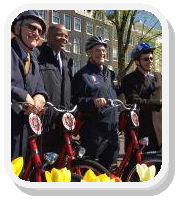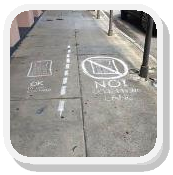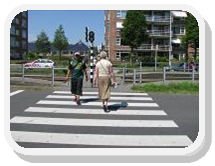U.S. Department of Transportation
Federal Highway Administration
1200 New Jersey Avenue, SE
Washington, DC 20590
202-366-4000

U.S. Department of Transportation
Federal Highway Administration
View the PDF Version [764 KB]
In this issue:
Secretary Foxx Travels to Europe for Innovation Exchange
NHTSA Releases 2014 Data for Pedestrian and Bicyclist Fatalities
NTSB Forum to Address Pedestrian Safety
Safe Transportation for Every Pedestrian (STEP) was recently selected as an Every Day Counts (EDC) 4 initiative by the Federal Highway Administration (FHWA). Pedestrians account for approximately 15 percent of all roadway fatalities, and the majority of these occur at uncontrolled crossing locations, such as nonintersections (e.g., mid-block), or at intersections with no traffic signal or stop sign. This EDC 4 innovation will help transportation agencies address these types of crashes by promoting cost-effective countermeasures with known safety benefits, such as "pedestrian hybrid beacons," pedestrian refuge islands, "road diets," crosswalk lighting, enhanced signing and marking, and "rectangular rapid flash beacons." "We are so excited to promote these six countermeasures through EDC-4. Our primary goal with STEP is to assist our stakeholders in providing safe pedestrian crossings," said STEP Program Manager Becky Crowe.
As background, EDC is a statebased model to identify and rapidly deploy proven but underutilized innovations. Through the EDC model, FHWA works with state and local transportation agencies and industry stakeholders to identify a new collection of innovations to champion every two years. Innovations are selected collaboratively by stakeholders, taking into consideration market readiness, impacts, benefits and ease of adoption of the innovation. Throughout the two-year deployment cycle, specifications, best practices, lessons learned and relevant data are shared among stakeholders through case studies, webinars and demonstration projects.
"Road diets" are also being promoted under a separate EDC 3 initiative that will continue through 2016. They can improve road safety for all road users (including pedestrians and bicyclists).
FHWA recently awarded a contract to Texas Transportation Institute to develop a Scaleable Risk Assessment Methodology (ScRAM). The contract lasts 4 years and allows 2 years to develop ScRAM and 2 years to provide technical assistance to localities that wish to use it. FHWA and other agencies within the USDOT are working together to assist states and cities in improving the safety and connectivity of their bicycling and walking networks. One of the key issues faced by stakeholders is assessing the degree to which exposure to risk changes over time or by location/region. The lack of an exposure metric creates at least three fundamental problems:
–Agencies do not have a consistent and effective way to compare different locations/ corridors and determine which to prioritize for pedestrian and bicyclist safety improvements;
–It is difficult to interpret regional trends in crashes involving pedestrians and bicyclists, because data on trips made by these modes is lacking (e.g., the magnitude of risk hinges on exposure); and
–Researchers conducting pedestrian/bicyclist safety studies often create their own unique exposure metrics, which makes direct comparison across studies and geographic locations difficult or impossible. FHWA hopes that ScRAM will assist with overcoming these issues. For more information, contact: tamara.redmon@dot.gov.

FHWA released several new resources over the last few months having to do with net-works and performance measures:
This guidebook highlights a range of ways that walking and bicycling investments, activity, and impacts can be measured and documents how these relate to goals identified in a community's planning process. It discusses how the measures can be tracked, while also highlighting data considerations and relevant case studies.
Performance management techniques pro-mote informed decision-making by relating community goals to the measurable effects of transportation investments. As more agencies plan, fund, and implement transportation projects that enhance walking and bicycling, they are seeking methods to aid in objectively planning and prioritizing their investments. In a constrained funding nevi-ronment, it is critical to be able to identify the projects and investments that will pro-vied the highest level of benefit. More agencies are using multiple transportation performance measures to track progress, develop effective solutions to needs, and prioritize needs and investments.

This resource highlights ways that different communities have mapped their existing and proposed bicycle networks. It shows exam-oles of maps at different scales, while also demonstrating a range of mapping strategies, techniques, and approaches. It is intended to serve as a resource as communities work to identify, plan, and improve their bicycle net-works. Connected networks are comprised of a range of facility types (e.g. bike lanes, separated bike lanes, shared use paths, etc.), linked together to facilitate short trips to and from destinations and long linear connections across a city or region.
This report, featuring information gathered by FHWA during a visit to the Netherlands in August 2015, explores similarities and differences in the approach to bicycle net-work planning and facility design in the Netherlands and the United States. Follow-inf a high level discussion of respective ed-sign approaches, this report highlights four specific themes observed in practice in Holland that are applicable to transportation practice in the U.S.

In April , U.S. Secretary of Transportation Anthony Foxx took a trip to northern Europe to take part in an innovation exchange revealing how cities are getting smarter about transportation, most specifically bicycle-pedestrian infrastructure. He was joined by key department staff and mayors who are taking part in the Mayors' Challenge for Safer People, Safer Streets.
Secretary Foxx said of his trip, "As we work to help define what it means to be an American 'Smart City,' and lead the country in planning for the challenges of the future, I [am] excited to discuss how we make our neighborhoods here at home more inclusive, multi-modal, and improve access to economic opportunity." Secretary Foxx noted that FHWA has been paying attention to European cities like Copenhagen and Amsterdam, because well over one-third of people get around by bicycle. These cities use very safe networks of roads designed with lanes, signals, and other fa-tures for bicycles, and (as demonstrated in the article above about the Bicycle Net-work Planning report) FHWA has studied what makes them work.

This literature review on the effect of elev-tronic device (cell phones, smart phones, etc.) use on pedestrian safety is part of a research project sponsored by NHTSA. A literature review was conducted and summarized into three sections: pedestrian distraction, driver distraction, and pedestrian-vehicle interactions. Within each section, the findings are further divided into several subsections based on the study methodologies, such as naturalistic observations, simulation, laboratory, or crash database analysis.
"As we work to help define what it means to be an American "Smart City," and lead the country in planning for the teal-lenges of the future, I was excited to discuss how we make our neighborhoods here at home more inclusive, multi-modal, and improve access to economic opportunity.." —U.S. Transportation |
The study's main finding is that pedestrian distraction is a real problem of which the effects can be detected in crash data, naturalistic behavioral observations, virtual environment simulator studies, and the laboratory. Distraction changes the way pedestrians walk, react, and behave, including safety-related behaviors. However, there are no studies showing a direct link between the behavioral effects of distraction and pedestrian crash risk.
Communities across the country are encouraging walking and biking to meet safety, health, livability, equity, and mobility goals. This primer is intended for highway safety professionals, including State Highway Safety Officials, as well as their partners and grantees, as a reference for an integrated and comprehensive effort to improve pedestrian and bicycle safety and support broader transportation-related goals. The primer summarizes the most promising infrastructure treatments and behavioral programs available for addressing specific safety problems and highlights how these approaches can be combined and implemented. It identifies opportunities for various agencies to collaborate and combine their respective approaches and funding for a more comprehensive program. It also offers real-world examples of what States and local jurisdictions are doing to address pedestrian and bicycle issues in a comprehensive manner.

NHTSA recently released data fact sheets for pedestrians and bicyclists. Some notable information from the fact sheets for 2014 includes:
–4,884 pedestrians were killed and an estimated 65,000 injured in traffic crashes in the United States.
–Pedestrian deaths accounted for 15 percent of all traffic fatalities in motor vehicle traffic crashes.
–The 4,884 pedestrian fatalities were a 2-percent increase from 4,779 pedestrian fatalities in 2013.
–18 percent of the pedestrians killed in 2014 were struck in crashes that involved hit-and-run drivers.
–726 bicyclists were killed and an additional 50,000 injured in motor vehicle traffic crashes.
–Bicyclist deaths accounted for 2 percent of all motor vehicle traffic fatalities and made up 2 percent of the people injured in traffic crashes during the year.
–The number of bicyclists killed in 2014 is 3 percent lower than the 749 bicyclists killed in 2013.
–The decrease in 2014 is the first decrease after 3 years of increases in bicyclist fatalities.
NHTSA recently released preliminary 2015 data, which shows that pedestrian fatalities have possibly increased by 10 percent and bicyclist fatalities have possibly increased by 13 percent. In addition, overall roadway fatalities are showing an increase (7.7 percent for 2015) for the first time since 2008.

Tamara Redmon, Pedestrian Safety Program
Manager
Federal Highway Administration
1200 New Jersey Avenue SE
Room E71-303
Washington, DC 20590
Phone: 202-366-4077
Fax: 202-366-3222
E-mail: tamara.redmon@dot.gov
This Pedestrian and Bike Forum is available
on the Web at http://safety.fhwa.dot.gov/ped_bike/pedforum/
To receive information on future newsletters,
please use the e-subscription service provided
on this site: http://safety.fhwa.dot.gov/esubscribe.cfm#ped. Scroll down to "Pedestrian and Bicycle Safety" and select "subscribe" next to "Pedestrian Forum."
Helping Communities to provide safe and convenient transportation choices to all citizens, whether it's by walking, bicycling, transit, or driving is a high priority of the U.S. Department of Transportation. Each year, unfortunately, pedestrian and bicyclist fatalities comprise about 16 percent of all traffic fatalities and there are approximately 5,500 pedestrian and bicyclist deaths. Another 115,000 pedestrians and bicyclists are injured in roadway crashes annually. Pedestrian and bike safety improvements ed-pend on an integrated approach that involves the four E's: Engineering, Enforcement, Education, and Emergency Services. The Pedestrian and Bike Forum highlights recent pedestrian and bike safety activities related to the four E's that will help save lives.
The National Transportation Safety Board (NTSB) held their first forum to address pedestrian safety on May 10, and officials from U.S. DOT participated and made presentations. NTSB Vice-Chairman Bella Dinh-Zarr opened the forum by noting that nearly every two hours a person is killed or injured while walking in the United States – a rising toll since 2009.
According to the forum's experts, more specific data is needed in order to have a better understanding of the circumstances in which pedestrian crashes occur, including location; geometry/angle of impact; speed; and the presence of pew-tential distractions. Forum panelists conveyed that pedestrian deaths and injuries can be prevented through effective urban planning, roadway design that prioritizes pedestrians, and pedestrian-friendly vehicle design.
Forum panelists presented highway design countermeasures, including medians and pedestrian crossing islands in urban and suburban areas; pedestrian hybrid beacons; and "road diets" that reconfigure roads to make them safer for pedestrians while maintaining mobility. Many of the ideas presented reflect the philosophies of Vision Zero (the Swedish approach to road safety that has been adopted worldwide) and Complete Streets (the inclusive design approach that recognizes that a road should be responsive to the needs of all its users).

Technology was another focus area of the forum. According to one panelist, most pedestrian crashes could be mitigated or prevented through pedestrian detection technology in vehicles. This technology assists vehicles in detecting the pedestrian ahead and providing automatic braking. Vehicle headlights and better road lighting can also make a difference. By improving overall visibility, drivers are able to better detect pedestrians at night, when most fatal crashes occur. Other mitigation countermeasures, such as soft bumpers and hoods, and pedestrian airbags, can save lives by ameliorating the severity of injuries once the crash occurs.
The NTSB forum brought welcome attention to an urgent safety problem that deserves a continued focus. The U.S. DOT continues to work with States and cities that are committed to reducing pedestrian deaths in or-red to makes roads safer for all users.
